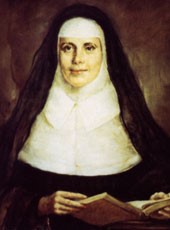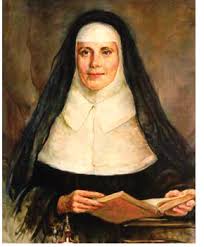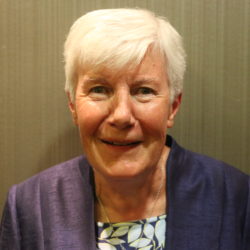Home | History & Heritage | Catherine McAuley | Work
Spirituality | Archives | Safeguarding Children | Projects We Support
Contact Us | Links / News
Who Is Catherine McAuley?
Catherine was an 18th century Catholic Irishwoman who was a fearless pioneer in laying the foundations of an educational, healthcare and social network that long outlasted her own initial efforts and which continues throughout the world today.
Why Would You Be Interested In Knowing Her?
Because over the past two hundred years, hundreds of thousands of people all over the world in places as far apart as Tonga and Tipperary, Silver Springs and Sunderland, Lima and Lusaka, have found a way to loving God and reaching out to people less fortunate than themselves through Catherine’s inspiration and her example.
Catherine’s Story

Catherine McAuley was born into a wealthy middle class Catholic family in Dublin, Ireland, in 1778. Her father died when she was very young and she spent a lot of her youth and adolescence moving house with her mother and younger brother and sister, invariably in a downwardly mobile direction. Oftentimes she had to depend on the goodwill of her extended family for accommodation. In her twenties she went to live in Coolock, in north county Dublin, in the home of William and Catherine Callaghan, a childless couple recently returned from India, who were looking for a suitable person to be a companion to Catherine Callaghan who was in bad health at the time.
Catherine spent all her early adult years with this family. The Callaghans came to love her as their own daughter and she returned their love. She inherited all the Callaghan’s wealth, not without opposition from other members of their family, which she used to build a house in Baggot Street where she could educate and house poor women and girls. In Catherine’s time, Dublin was a place where the divide between rich and poor was very great. If you were rich, Dublin was a wonderful place to live and enjoy life, if you were poor you had nothing. Poor women and girls were the most vulnerable group in this society.
Catherine’s own family thought she was foolish to spend all her inheritance on a building for the poor. Nothing daunted, she gathered a small group of volunteers from among well to do Dublin catholic women to help her run the school and take care of poor women who needed safe accommodation immediately.
Catherine never intended to set up a religious community of Sisters but it so happened in the society of her day in Dublin that after a few years of running a voluntary lay organisation she was faced with the choice of becoming the Foundress of a religious congregation herself or of handing the work over to another group. She founded the congregation of the Sisters of Mercy on the 12th, December 1831.
She was fifty three when that happened and for the last ten years of her life she continued to take care of her beloved Dublin poor, consistently widening the scope of her organisation from education and social work to healthcare and visitation of the poor in their homes. In the early years before the demands of the new congregation grew, she was personally involved in training the constant stream of new members into the way of life which she herself had taken on with energy and earnestness. As the news of her good work spread to places outside of Dublin she spent countless hours in coaches, on steamer packets and canal boats opening up new foundations wherever she was invited to go.

For her time, she was a much travelled lady. Before she opened her schools for the poor in Baggot Street she went to France to observe the methodology for teaching the young there. She founded two convents in England, one in Birmingham and the other in London before she died. In her many letters, she wittily describes her travels through the length and breadth of Ireland by coach and canal boat making new foundations in conditions that, more often than not, were less than ideal.
In one letter Catherine wrote she describes her time in a town called Birr in the centre of Ireland. She was making a foundation there in the middle of winter and the place was so cold that she had to melt the butter on a burning sod of turf in order to spread it on the bread!
She died in the house in Baggot Street on November 11th, 1841 from a diseased lung. She was penniless by that time having spent every penny of her considerable in heritance on the poor. Before she died she asked that she be buried in the ground just like any other poor person, a request that was complied with by those whom she left behind. Her grave, marked slightly more elaborately than Catherine would have expected, is still to be found in the garden of the house on Baggot Street. People come every day to pray at her tomb and one may ask oneself why this is so?
The answer to that question may be found in the fact that this woman ‘Catherine of Dublin’ as she is sometimes called was very ordinary and yet remarkable in many ways.
Catherine Was ‘Down To Earth’ And Fun To Be With
All through her life Catherine showed herself to be intelligent, practical and prayerful and above all deeply kind to others. If holiness is; “doing the next thing you have to do , doing it with your whole heart, and finding delight in doing it” (Meister Eckhart, 1260-1329), then Catherine certainly was a wise and holy woman. Delightful stories are told by those who knew her about her warmth and fun loving spirit, how she would enter wholeheartedly into times of relaxation with other members of her community often preparing funny poems and songs to help pass the time. Her letters were another example of how, no matter how tired she was at night, she could always find time to write to someone she knew was hoping for a word from her and right up to the end of her life she continued to make foundations under the most difficult conditions urged on by the certainty that; “while we place all our trust in God – we must act as if all depended on ourselves”.
Catherine Was A Pioneer And An Innovator
She was an innovator. She worked with systems but was always able to move beyond them. As a laywoman she established the first shelter for unemployed women in Dublin. She opened outlets to sell the hand work done by the women and children in the school in which she taught. She travelled to France to learn educational systems before she opened her own schools. Generally, she brought education for poor girls and women to the forefront in the Ireland of her day.
As a Foundress, she managed to ensure that the members of her congregation were not bound by enclosure so that they could go to the poor rather than expecting the poor to come to them. This innovation earned the title “The Walking Nuns” for herself and her Sisters as they moved among the poor and sick of Dublin in the early nineteenth century. She favoured the practice of holding receptions and professions of new members in the parish church where new foundations were made. The profession of Mary Teresa Purcell in 1836 in Tullamore started a trend that is followed to this day.

Catherine Was A Woman Of Mercy
Mercy was the motivating power underlying Catherine’s love for the poor. It was not philanthropy or human solidarity because it was directed towards the weakest. Neither was it to preserve their Catholic faith nor to win back people who had gone over to Anglicanism or Protestantism because for Catherine there was no difference between Catholic and Protestant when it came to helping, relieving or instructing one’s neighbour. She institutionalised her fervent love of neighbour in the Rule for her Congregation describing Mercy as “the principal path marked out by Jesus Christ for those who wish to follow his example”.
Her use of her own resources, whether of wealth, connections or physical vitality show that she was living in the spiritual house whose walls as St. Augustine says are ‘walls of hope’. For Catherine, Mercy in the form of a compassionate practical response to need was where she believed she was called by God.
Catherine Was A Woman Of Faith

Catherine was essentially a woman of faith who trusted God implicitly. As with Jesus so with Catherine, surrender to the love of the Father inevitably meant surrender to the Cross. Catherine was no stranger to the Cross as she said herself “we were founded on Calvary there to serve a crucified Redeemer”. When we look at her however we see a woman who through all she suffered, learned that she could not be her own saviour. She did not take herself too seriously and her “mirth”, her irrepressible joy was constantly in evidence in her fun poems, her good humour in defusing tense community situations, her capacity to make fun and to laugh especially at herself. As she matured this weaving of joy and pain was expressed through a profound trust in the Providence of God expressed so well in her prayer which is titled the Suscipe. God, Jesus Christ, her Catholic faith, were very important to her from her earliest days. A favourite saying of Catherine’s, especially as she had so much travelling to do was:
“our hearts are centered on God”
and new members of her Congregation would often quote her as saying that:
“your whole life should be a continual act of prayer and praise”.
This gives us some insight into her own relationship with God. When she was growing up and well into her early adult years circumstances forced her to live in households that were antagonistic to the faith she held and so she learned to give expression to her love for God in ordinary simple ways: like seeing the Cross in the panels of a window or the branches of a tree because no image of a Cross was permitted in the house where she lived. She had to search and fight for her faith, which she learned to do in a way that was sensible, courteous but very tenacious. Her own lived witness to charity was the companion volume to the Scripture in the study of which she found the secret of life and love. After Catherine died a very good friend of hers said that “She was a woman of God and God made her a woman of vision”.
Catherine died the death that any Christian might hope and pray for and which every Christian must admire. Without any fuss, without any fear she gave herself to God as she had given herself to him all through her life.
Catherine Was A Holy Woman

The Church has great need of saints. The real innovators in the Church are the saints, holy people whose lives are dramatic with a humble and homely heroism. Holiness is found in a common day to day life. A saint is someone who offers so little resistance to the presence and the power of God, that God is able to pour himself freely into the person’s heart and fill it with Love. That Love flows out through the holy person’s hands out to all those who have need in the world – the poor, the lonely, the sick, the homeless, the helpless, all who have need of God’s Love whatever shape or form that need takes. Minds are moulded and hearts are moved not by abstractions but by models. Catherine is one such a model for so many people over the past 170 years.
Catherine’s spirit lives on and continues to be attractive to people today
The Rule that she wrote for her fledgling congregation, her letters, the materials that she copied down and shared during retreat times, the kind of emphases she underlined in her “instructions” of newer members, all these give us an insight into her spirit and is the distilled essence of what she considered important. Her pithy description of what being a woman of Mercy as someone who has:
“an ardent desire to be united to God and serve the poor”
sums up much of who Catherine was and the reason why people find it so easy to identify with her today. Without Catherine’s powerful example so many women could never have linked their own search for God with the care and education of the poor. For all who know her and share in her spirit, Catherine is a living powerful symbol who nourishes spirituality and goads people to undertake activities for the relief of the poor that will long outlive them.
Spend some time with Sisters of Mercy anywhere in the world and you will experience friendly hospitality and a compassionate openness to all who are suffering or in difficulty of any kind. This is something that is difficult to define but you will know it when you meet it. Not every Mercy sister is invariably hospitable or compassionate but in the overall, Catherine’s spirit of Mercy shines through. In today’s world Mercy Sisters are acutely aware that in every place where Mercy Sisters have been or are, without any credit due to themselves, men, women and children, who have come to know Catherine and her story, are irresistibly drawn to her and turn to her for help in all their difficulties. This is a trend that is gathering momentum all the time.
Conclusion
The above is a very short and inconclusive account of the life and spirit of a woman who is a very real example of what it means to be a conduit of God’s loving and compassionate Mercy in the world. She understood and lived the conviction that Christ has no body now but ours and exemplifies that each one of us brings our own unique gift to living that vision in the place and time in which we find ourselves. Heidegger tells us that our future comes to meet us out of our past. So, even in this post modern and technological age a study of the life, spirituality and vision of Catherine McAuley in its transparent simplicity is as apt to inspire and challenge today as it was in her lifetime.
We conclude with the prayer that Catherine made her own prayer. It is called the Suscipe.
Why not make it yours?
My God I am yours for time and eternity
Teach me to cast myself entirely into the arms of your Loving Providence
With a lively unlimited confidence in your compassionate tender pity
Take from my heart all painful anxiety
Let nothing sadden me but sin
Nothing delight me but the hope of coming to the possession of you, my God and my All in your everlasting Kingdom.
Amen
We have a story, the story of Mercy.
Let us together
• Learn this story
• Contemplate and pray this story
• Own this story
• Celebrate this story
• Share this story
Then let us see where God will lead us!
The above text was written by Sr. Brenda Dolphin who is the Postulator for the Cause of the Canonisation of Catherine McAuley
Learn more about Catherine McAuley


